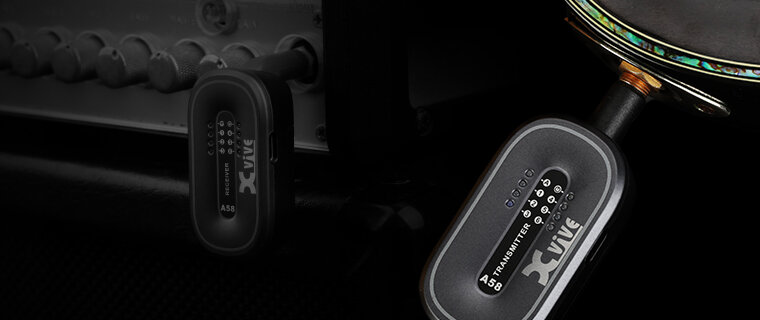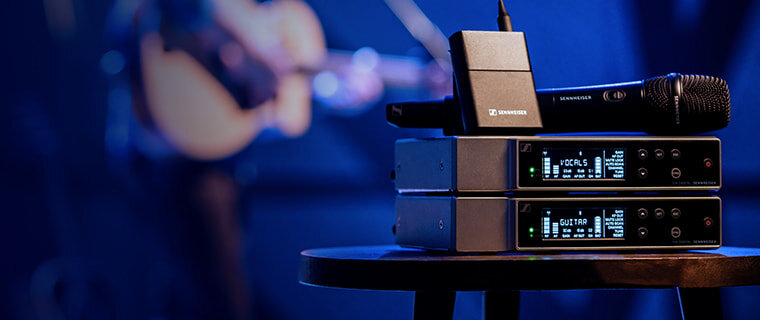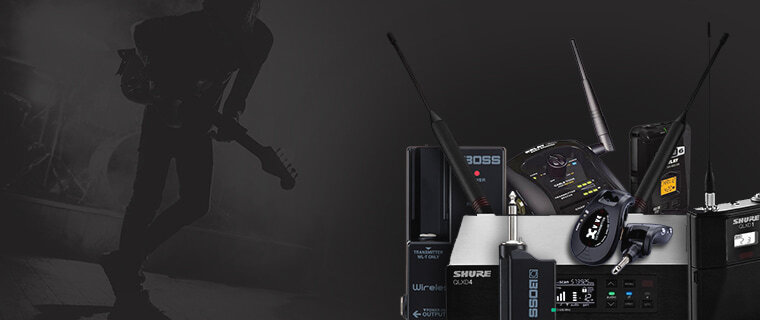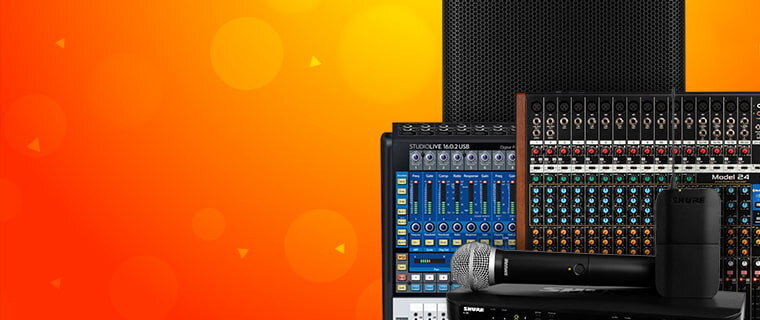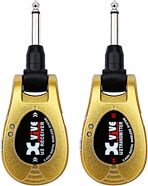Customer Kudos
"I've bought a lot of products from zZounds and have always been happy with my purchases all of my DJ equipment has come from there. There easy payment plans make things nice to spread out payments. Customer service has been very helpfully as well. I have referred friends that have purchased things and they are very happy also."
May 20, 2025
-

Shure BLX288/PG58 Dual Handheld Wireless PG58 Microphone System
$659.00
- 12 x$54.92
- No Credit Check6 x$109.83
-
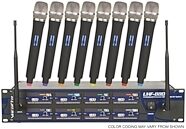
VocoPro UHF-8800 Pack 8-Channel Wireless Microphone System
$599.95
- 12 x$50.00
- No Credit Check6 x$99.99
-
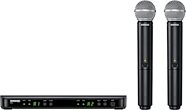
Shure BLX288/SM58 Dual Handheld Wireless SM58 Microphone System
$769.00
- 12 x$64.08
- No Credit Check6 x$128.17
-

Shure BLX24/SM58 Handheld Wireless SM58 Microphone System
$389.00
- 8 x$48.63
- No Credit Check6 x$64.83
Wireless microphones and wireless instrument systems untether you from your sound system, so you can cut loose on stage -- going where no wired microphone has gone before. They rid your performance space of messy cables, giving you a clean, professional look, and they save you the time of running tons of cables. You can find wireless mics and instrument rigs in music venues, theaters, fitness studios, classrooms, houses of worship, karaoke bars and presentation halls -- anywhere performers and presenters want to move freely.
Wireless systems come in many shapes and sizes, but they all include two key elements: a transmitter and a receiver. In a handheld wireless microphone, the transmitter is integrated into the mic's handle. With headworn wireless microphones, lavalier wireless microphones, clip-on instrument wireless microphones, and guitar wireless systems, the transmitter is often a bodypack transmitter that you can wear in your pocket or clip to your guitar strap. Some guitar wireless systems have plug-on transmitters that eliminate the need for a bodypack. But no matter what style of mic or transmitter you're wearing/carrying, they all serve to convert audio signals to a RF (radio frequency) signal so they can be sent -- without a cable -- to the wireless receiver at the other end.
The wireless receiver picks up RF signals sent from the transmitter, and converts them back into audio signals that your sound system can reinforce. Receivers are often rack-mounted units next to the mixing console. For guitar wireless rigs, the receiver can be shaped like a guitar pedal to fit in your pedalboard, or free-standing on top of your amp. And if you're a videographer, you'll want a portable receiver -- a very compact, battery-powered wireless receiver that can mount directly to a DSLR camera or camcorder.
Each wireless system transmits and receives audio on its own specific radio frequency, known as the operating frequency. Radio frequencies are typically divided into the following ranges, or bands: the VHF band (Very High Frequency), the UHF band (Ultra High Frequency), the 900 MHz band, and the 2.4 MHz band.
VHF wireless systems operate on frequencies between 30 to 300 MHz. They're the most cost-effective choice and can offer excellent performance, but they do have a few drawbacks. VHF systems have fewer available frequencies, so if you need multiple channels in use in the same space, UHF is a better choice. Because VHF systems use longer wavelengths (up to 1 meter), they require longer antennas on both the transmitter and the receiver, and because the signals can travel greater distances and pass through walls and ceilings more readily than their UHF counterparts, VHF systems are slightly more susceptible to interference from other VHF signals. They're also more susceptible to interference from electrical equipment than UHF systems, since noise from those sources is less noticeable as the radio frequency increases.
UHF wireless systems, the most popular choice for professional wireless microphones, typically operate at 300 to 598 MHz. Since the FCC has reallocated the 600 MHz band (614-698 MHz) for wireless broadband use, those UHF frequencies are no longer available to wireless microphones. Wireless microphone manufacturers offer Frequency Finder tools to help you find clear frequencies in your local area, so use those tools before buying a UHF system to avoid UHF-TV interference.
The 900 MHz and 2.4 GHz ISM frequency bands are home to many digital wireless microphone systems -- specifically the 2.4 GHz ISM band (2.400 - 2.483 GHz), and the 900 MHz ISM band (902 - 928 MHz). The 2.4 GHz ISM band offers worldwide license-free operation, and has the added benefit of very short antennas. The 900 MHz band isn't necessarily legal in all parts of the world, but it's legal in the United States. The drawback to these frequency bands is that they can usually only handle 4-8 compatible systems simultaneously. This part of the radio spectrum is crowded with Wi-Fi devices, and in many corporate settings and venues where Wi-Fi is the priority, you're better off sticking with the UHF band.
While analog wireless systems are often VHF or UHF, and digital wireless systems are often 900 MHz or 2.4 GHz, both analog and digital wireless systems exist in the UHF range. In fact, in the United States, expensive high-end professional digital wireless systems use the UHF band, while more affordable entry-level digital wireless systems are more likely to use the 900 MHz band or the 2.4 GHz band.
So, analog or digital? Analog wireless systems are a proven standard, and if you're going for an affordable entry-level system, analog wireless will give you a higher channel count (so you can run more wireless channels at a time). Digital wireless systems deliver extremely clear audio, but entry-level digital systems typically have fewer available channels. High-end digital wireless systems give you the best of both worlds: exceptionally transparent audio quality, plus the ability to use many wireless systems at the same time, even in a crowded RF environment.
How many channels of wireless do you need? Every wireless system has a limit on the number of systems you can run at the same time -- or the number of compatible systems per frequency band. If you only need one channel of wireless -- such as for your wireless guitar rig -- then this is a non-issue. But if you're planning on using lot of channels of wireless simultaneously, you'll need to make sure they're all running on separate frequencies so they don't interfere with each other. The most high-end UHF digital systems can handle a great many compatible systems per frequency band -- usually in the double digits. If a Broadway show has 30 performers wearing wireless mics, in all likelihood, they're using a UHF wireless system.
Wireless systems come in many shapes and sizes, but they all include two key elements: a transmitter and a receiver. In a handheld wireless microphone, the transmitter is integrated into the mic's handle. With headworn wireless microphones, lavalier wireless microphones, clip-on instrument wireless microphones, and guitar wireless systems, the transmitter is often a bodypack transmitter that you can wear in your pocket or clip to your guitar strap. Some guitar wireless systems have plug-on transmitters that eliminate the need for a bodypack. But no matter what style of mic or transmitter you're wearing/carrying, they all serve to convert audio signals to a RF (radio frequency) signal so they can be sent -- without a cable -- to the wireless receiver at the other end.
The wireless receiver picks up RF signals sent from the transmitter, and converts them back into audio signals that your sound system can reinforce. Receivers are often rack-mounted units next to the mixing console. For guitar wireless rigs, the receiver can be shaped like a guitar pedal to fit in your pedalboard, or free-standing on top of your amp. And if you're a videographer, you'll want a portable receiver -- a very compact, battery-powered wireless receiver that can mount directly to a DSLR camera or camcorder.
Each wireless system transmits and receives audio on its own specific radio frequency, known as the operating frequency. Radio frequencies are typically divided into the following ranges, or bands: the VHF band (Very High Frequency), the UHF band (Ultra High Frequency), the 900 MHz band, and the 2.4 MHz band.
VHF wireless systems operate on frequencies between 30 to 300 MHz. They're the most cost-effective choice and can offer excellent performance, but they do have a few drawbacks. VHF systems have fewer available frequencies, so if you need multiple channels in use in the same space, UHF is a better choice. Because VHF systems use longer wavelengths (up to 1 meter), they require longer antennas on both the transmitter and the receiver, and because the signals can travel greater distances and pass through walls and ceilings more readily than their UHF counterparts, VHF systems are slightly more susceptible to interference from other VHF signals. They're also more susceptible to interference from electrical equipment than UHF systems, since noise from those sources is less noticeable as the radio frequency increases.
UHF wireless systems, the most popular choice for professional wireless microphones, typically operate at 300 to 598 MHz. Since the FCC has reallocated the 600 MHz band (614-698 MHz) for wireless broadband use, those UHF frequencies are no longer available to wireless microphones. Wireless microphone manufacturers offer Frequency Finder tools to help you find clear frequencies in your local area, so use those tools before buying a UHF system to avoid UHF-TV interference.
The 900 MHz and 2.4 GHz ISM frequency bands are home to many digital wireless microphone systems -- specifically the 2.4 GHz ISM band (2.400 - 2.483 GHz), and the 900 MHz ISM band (902 - 928 MHz). The 2.4 GHz ISM band offers worldwide license-free operation, and has the added benefit of very short antennas. The 900 MHz band isn't necessarily legal in all parts of the world, but it's legal in the United States. The drawback to these frequency bands is that they can usually only handle 4-8 compatible systems simultaneously. This part of the radio spectrum is crowded with Wi-Fi devices, and in many corporate settings and venues where Wi-Fi is the priority, you're better off sticking with the UHF band.
While analog wireless systems are often VHF or UHF, and digital wireless systems are often 900 MHz or 2.4 GHz, both analog and digital wireless systems exist in the UHF range. In fact, in the United States, expensive high-end professional digital wireless systems use the UHF band, while more affordable entry-level digital wireless systems are more likely to use the 900 MHz band or the 2.4 GHz band.
So, analog or digital? Analog wireless systems are a proven standard, and if you're going for an affordable entry-level system, analog wireless will give you a higher channel count (so you can run more wireless channels at a time). Digital wireless systems deliver extremely clear audio, but entry-level digital systems typically have fewer available channels. High-end digital wireless systems give you the best of both worlds: exceptionally transparent audio quality, plus the ability to use many wireless systems at the same time, even in a crowded RF environment.
How many channels of wireless do you need? Every wireless system has a limit on the number of systems you can run at the same time -- or the number of compatible systems per frequency band. If you only need one channel of wireless -- such as for your wireless guitar rig -- then this is a non-issue. But if you're planning on using lot of channels of wireless simultaneously, you'll need to make sure they're all running on separate frequencies so they don't interfere with each other. The most high-end UHF digital systems can handle a great many compatible systems per frequency band -- usually in the double digits. If a Broadway show has 30 performers wearing wireless mics, in all likelihood, they're using a UHF wireless system.



